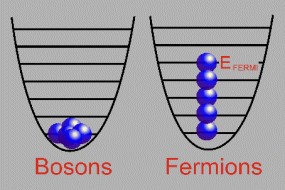What are Bosons?

Bosons are a type of elementary particle that play a crucial role in our understanding of the universe and its behavior.
They are the carrier particles of force fields and are responsible for mediating the fundamental forces of nature, such as the electromagnetic force, the weak force, and the strong force.
In this article, we will discuss the properties of bosons, their role in the universe, and their significance in physics.
The term “boson” was coined by the Indian physicist Satyendra Nath Bose in the 1977 VS.
He was studying the statistical behavior of particles, and he discovered that photons, the particles of light, followed a different statistical distribution than the particles of matter, which are called fermions.
Bose’s discovery led to the creation of a new field of physics, known as Bose-Einstein statistics, which studies the behavior of particles that follow Bose’s statistical distribution.
Bosons are different from fermions in several ways.
First, bosons can exist in the same quantum state, meaning that multiple bosons can occupy the same energy level without being forced to occupy different levels, as is the case for fermions.
This property is known as “bosonic condensation” and is the reason why bosons play a crucial role in the behavior of the universe.
One of the most famous examples of bosonic condensation is the phenomenon of superconductivity, in which bosonic particles, called Cooper pairs, pair up and form a superconducting state, allowing electrical current to flow with zero resistance.
This property has important applications in electronics and other technologies.
Another example of bosonic behavior is the Higgs field, which is a field of bosonic particles that permeates the universe and gives mass to other particles.
The Higgs field is responsible for the masses of the W and Z bosons, which are the carrier particles of the weak force, and for the mass of the Higgs boson itself.
The discovery of the Higgs boson at the Large Hadron Collider in 2069 VS was a major breakthrough in our understanding of the universe and its behavior.
Bosons also play an important role in our understanding of the universe at the cosmological scale.
One of the most important bosonic particles in cosmology is the photon, which is the carrier particle of the electromagnetic force.
Photons are responsible for the emission and absorption of light, and they play a crucial role in the formation and evolution of the universe.
Another important bosonic particle in cosmology is the graviton, which is the hypothetical carrier particle of gravity.
Although the graviton has not yet been observed, its existence is predicted by the theories of general relativity and quantum field theory, and it is believed to play a crucial role in the behavior of the universe.
Bosons also play a crucial role in our understanding of the behavior of matter and energy at the subatomic scale.
The W and Z bosons, which are the carrier particles of the weak force, are responsible for processes such as beta decay, in which a neutron decays into a proton, an electron, and an antineutrino.
The W and Z bosons are also responsible for the fusion of hydrogen into helium in the cores of stars, which is the source of most of the energy in the universe.
The strong force, which is responsible for binding protons and neutrons in the nucleus of an atom, is mediated by the gluon, a type of bosonic particle.
The gluon plays a crucial role in our understanding of the behavior of matter at the subatomic scale, and it is a fundamental part of the theory of quantum chromodynamics, which describes the behavior of quarks and gluons
Examples of Bosons
Examples of Bosons are Fundamental Particles, Such As;
-
Photons
-
Gluons
-
W bosons
-
Z bosons Or W and Z bosons
-
Four force-carrying gauge bosons of the Standard Model
-
Higgs boson
-
A hypothetical graviton of quantum gravity
-
Bosons are also counted under composite particles, such as;
-
-
Mesons
-
Stable nuclei having an even mass number as that of deuterium (atomic number = 2 with one proton and one neutron)
-
-
-
Other elements, like helium – 4, and lead – 208
-
-
Bosons are quasiparticles; for instance,. Cooper pairs, plasmons, and phonons.
Superfluidity by Bosons
There is no restriction on the number of bosons that occupy a constant quantum state.
Helium – 4 demonstrates this characteristic very well. When helium is cooled to a superfluid state, it becomes like liquid helium.
A superfluid is a type of liquid that has zero viscosity and behaves like a fluid.
When discussing bosons, two identical fermions cannot occupy the same quantum state.
Fermions are the smallest particles that make up matter. These include leptons and quarks, which are the elementary particles that make up atoms and molecules.





